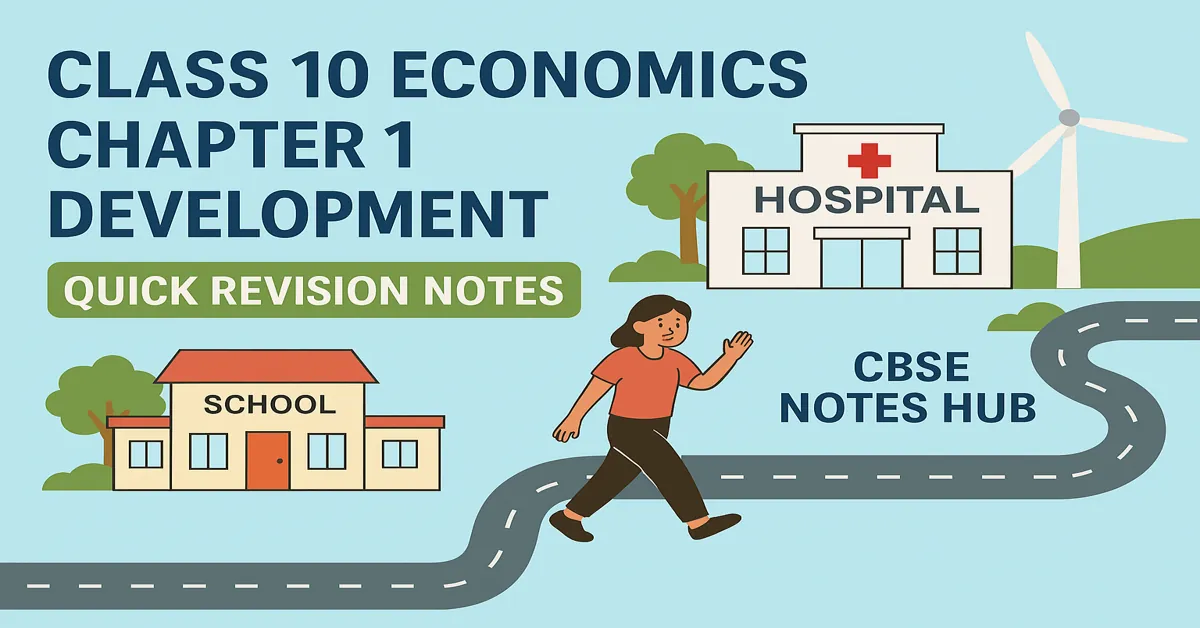Class 10 Chapter Development Notes help us understand how progress is measured in a country beyond just income. In this chapter, we learn about indicators like life expectancy, literacy rate, and infant mortality rate. These notes cover definitions, facts, and key points to help you revise quickly and effectively for your exam. Also, don’t forget to check out the Romanticism in Europe Class 10 Notes for history!
Easy and quick Revision notes
Chapter – I
Development
Development – Progress (positive change) in the economic, social, political, and administrative spheres of the country.
Characteristics of development –
(1) Different people have different development goals.
(2) What may be development for one may not be development for another.
(3) It may even be destructive for others.
(4) For development, people look at mixed goals.
Income is the most important component of development.
Besides Income – People also seek equal treatment, freedom, security, and respect of others, good health, peace, literacy, etc. Opportunities for all, pollution-free environment, and longevity.
National Development – Refers to the development of the country, which includes improvement in the living standard of people, increase in per capita income, and providing social amenities like education, medical care, social services, etc. to the citizens of the country.
Classifying countries – Per capita income criteria of the World Bank.
Per capita income = Total income of the country / Total population.
Countries with higher income –
Considered developed countries (rich countries) with a per capita income of US $12,056 per annum and above in 2017.
Countries with less income – Considered low-income countries with a per capita income of US $955 or less per annum in 2017.
India comes in the category of low middle-income countries.
Per capita income of India in 2017 – Just US $1820 per annum.
The per capita income criterion or average income is not considered a good criterion because it does not tell us about income inequalities.
Besides income, what can be the other attributes to compare economic development?
(1) Infant Mortality Rate – IMR is the number of children that die before the age of one year as a proportion of 1000 live children that are born in a particular year.
(2) Literacy Rate – It measures the proportion of the literate population in the 7 and above age group.
(3) Net Attendance Ratio – It is the total number of children of the age group 14 and 15 years attending school as a percentage of the total number of children in the same age group.
(4) Body Mass Index – It is the ratio of the weight of the body (in kg) to the square of the height of the body (in metres). It is an indicator of nutritional status.
(5) Life Expectancy at Birth – It denotes the average expected length of life of a person at the time of birth.
Public facilities – Public facilities are those basic facilities that are provided to the public by the government, like basic health and education.
Human Development Report – Published by UNDP.
Compares countries based on the educational levels of people, their health status, and per capita income.
UNDP – United Nations Development Programme.
Human Development Report (HDR) – Measures development using Gross National Income, life expectancy at birth, and mean years of schooling.
HDI Rank in the world (2018) out of a total of 189 countries –
India – 130
Sri Lanka – 76
Myanmar – 148
Pakistan – 150
Nepal – 149
Bangladesh – 136
The HDI report was first published in 1990.
Sustainability of Development
It is a modern concept of development. It focuses on maintaining a certain development rate for the present and future generations.
Renewable Resources – The resources which are replenished by nature, for example, vegetation (crops and plants), water, solar energy, etc.
Non-renewable Resources – The resources which cannot be replenished (renewed) by nature in a short period of time.
Sustainable Development – Development that meets the needs of the present generation without compromising the needs of future generations.
The development should be sustainable. Only then will we save our environment. The issue of environmental degradation is no longer region or nation specific.
🔗 Also, explore our detailed notes on Power Sharing for a better understanding of democratic practices.
Here are some frequently asked questions related to this chapter to help you understand it better:
Q.1 What is meant by Net Attendance Ratio?
Answer. It is the total number of children of age group 14 and 15 years attending school as a percentage of total number of children in the same age group.
Q.2 What is meant by Per Capita Income?
Answer: It is the average income per person, calculated by dividing the total income of the country by its total population.
Q.3 Define life expectancy.
Answer: It denotes the average expected length of life of a person at the time of birth.
Q.4 What is meant by Infant Mortality Rate?
Answer: It is the number of children that die before the age of one year as a proportion of 1000 live children born in a particular year.
Q.5 Define literacy ratio.
Answer: It measures the proportion of literate population in the 7 years and above age group.
Q.6 What is meant by Human Development Index (HDI)?
Answer: It is a report by UNDP which measures development using Gross National Income, Life Expectancy at birth and Mean years of schooling.
Q.7 What is meant by Gross Enrollment Ratio?
Answer: It is the percentage of children enrolled at a level of education compared to the total number of children in the same age group.
Q.8 State any two goals other than income.
Answer: Two such goals are equality and freedom.
Conclusion: In this chapter, we have learned about the key indicators of development and how they help us understand the real progress of a country. Remember, development is not just about income but also about providing equality, freedom, and opportunities for all. For more detailed notes and updates, visit CBSE Notes Hub.


